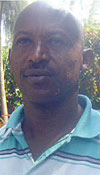Standing tall and muscular, Aimable Kizito can be mistaken for a youth. Though he is in his late 40’s, he looks healthy, athletic and very happy. He discloses his key to happiness, life-saving.


Standing tall and muscular, Aimable Kizito can be mistaken for a youth. Though he is in his late 40’s, he looks healthy, athletic and very happy. He discloses his key to happiness, life-saving.
Kizito is a life-saver at La Palisse Hotel in Nyandungu. He became a life-saver from the time he was a mere 15 year old.
"I started swimming at the age of 9 and became a life-saver in 1976 when I was still a teenager,” he says with a smile.
Talking about his profession and appreciating nature is the best conversation Kizito can ever have. Because of this, he has improvised ways to make other people love and do what he does.
Kizito is married and he’s blessed with four children. He says he is doing his best to make his four children take up his trade.
"I started with teaching all of them how to swim. They are perfect swimmers but it’s only one who is interested in taking up Life-saving,” says Kizito.
The Life saver is also a coach for a swimming club known as "club les dauphins” where several national swimmers have taken their swimming lessons. During holidays, he gets the chance to train school children in swimming. He awards marks and rewards the best swimmers.
"This I do to show the young generation that unlike other professions, swimming is one that rewards all the time.”
Though being a Life-saver didn’t come on a silver platter, Kizito was always determined to go for what he wanted. To him, saving lives in Lake Tanganyika was his day to day dream as he was growing up.
Born in Burundi, Kizito recalls his parents being concerned about the lot of time he spent on swimming than school.
"If you want to be someone in life, at times you have to be rebellious,” he says.
Yes, he encountered hardships but he never gave up. When he was pursuing his first certificate in 1976, he had to do a lot to convince his trainers that he was worth it.
Earning the certificate involved swimming for a gruelling 12 kilometres.
"We would be taken by boats, placed in the middle of the lake and we could swim back.”
During one of the long distance swimming stints, something that keeps in Kizito’s memory happened.
His best friend, one he had convinced into swimming was eaten up by a crocodile. It all happened when they were swimming close to each other but Kizito only learnt of it after his friend had disappeared.
"I was very scared; the waters weren’t as friendly as I had always thought. But for some reason this gave me the guts to continue, at least for my deceased friend’s memory,” Kizito sadly recalls.
The fateful day also made Kizito confirm his future career; gaining more techniques to save people from unfriendly reptiles like the crocodiles.
Life saving has become part of Kizito’s life. All day long he seats besides the swimming pool to monitor the people who are swimming.
"What I dread most is letting death claim any of my swimmers’ life.”
He says that daily he at least saves two people from drowning.
There is more reason why many would feel safe in the pool with Kizito lurking nearby. He has three Life saving certificates from The International Olympic Committee.
When he talks about the advantages of Life saving and swimming, the list seems endless.
The professional swimmer credits swimming as an exercise and medicine. Doctors prescribe swimming as a remedy for backaches and breathing problems.
Kizito hopes that more people will take up Life-saving as a profession.
"Within a few years time, we shall have more life savers. All that is needed is a professional swimming school,” he says.
Ends


